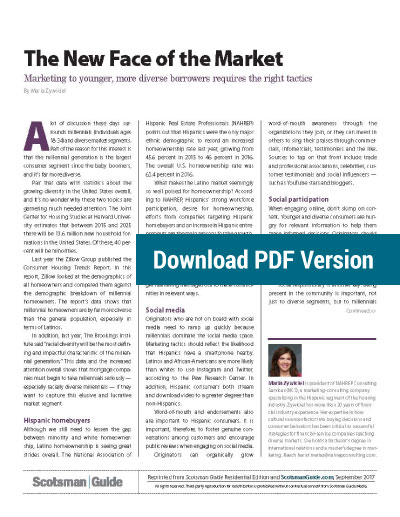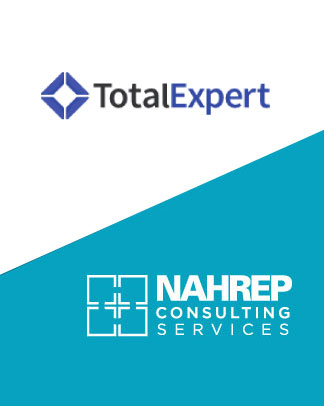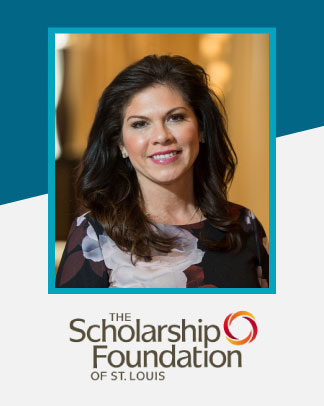Marketing to younger, more diverse borrowers requires the right tactics
A lot of discussion these days surrounds millennials (individuals ages 18-34) and diverse market segments. Part of the reason for this interest is that the millennial generation is the largest consumer segment since the baby boomers, and it’s far more diverse.
Pair that data with statistics about the growing diversity in the United States overall, and it’s no wonder why these two topics are garnering much needed attention. The Joint Center for Housing Studies at Harvard University estimates that between 2015 and 2025 there will be 13.6 million new household formations in the United States. Of these, 40 percent will be minorities.
Last year the Zillow Group published the Consumer Housing Trends Report. In this report, Zillow looked at the demographics of all homeowners and compared them against the demographic breakdown of millennial homeowners. The report’s data shows that millennial homeowners are by far more diverse than the general population, especially in terms of Latinos.
In addition, last year, The Brookings Institute said “racial diversity will be the most defining and impactful characteristic of the millennial generation.” This data and the increased attention overall shows that mortgage companies must begin to take millennials seriously — especially racially diverse millennials — if they want to capture this elusive and lucrative market segment.
Hispanic homebuyers
Although we still need to lessen the gap between minority and white homeownership, Latino homeownership is seeing great strides overall. The National Association of Hispanic Real Estate Professionals (NAHREP) points out that Hispanics were the only major ethnic demographic to record an increased homeownership rate last year, growing from 45.6 percent in 2015 to 46 percent in 2016.
The overall U.S. homeownership rate was 63.4 percent in 2016. What makes the Latino market seemingly so well poised for homeownership? According to NAHREP, Hispanics’ strong workforce participation, desire for homeownership, efforts from companies targeting Hispanic homebuyers and an increase in Hispanic entrepreneurs are the main reasons for the growth.
Among Latino millennials, the desire for homeownership remains strong; however, there is still a need for mortgage originators to tweak their approaches and communication tactics. Following are some ideas on how to get marketing messages out to these communities in relevant ways. Social media Originators who are not on board with social media need to ramp up quickly because millennials dominate the social media space.
Marketing tactics should reflect the likelihood that Hispanics have a smartphone nearby. Latinos and African-Americans are more likely than whites to use Instagram and Twitter, according to the Pew Research Center. In addition, Hispanic consumers both stream and download video to a greater degree than non-Hispanics.
Word-of-mouth and endorsements also are important to Hispanic consumers. It is important, therefore, to foster genuine conversations among customers and encourage public reviews when engaging on social media.
Originators can organically grow word-of-mouth awareness through the organizations they join, or they can invest in others to sing their praises through commercials, infomercials, testimonials and the like. Sources to tap on that front include trade and professional associations, celebrities, customer testimonials and social influencers — such as YouTube stars and bloggers.
Social participation
When engaging online, don’t skimp on content. Younger and diverse consumers are hungry for relevant information to help them make informed decisions. Originators should make sure their social content is rich, but also easy to understand and relevant to their diverse audiences. Millennials are savvy consumers and conduct a lot of research before they buy.
Social responsibility is another key. Being present in the community is important, not just to diverse segments, but to millennials as well. According to Omnicom Group’s Cone Communications, 70 percent of millennials look to support brands that back causes they care about. Consequently, social responsibility has become a considerable priority for brands targeting this segment. Originators should look for ways to show their company’s values and support of social issues.
Finally, community involvement does matter. Mortgage companies must be present in and support the segments they wish to serve. There is no shortcut to building relationships at a market-by-market level. Also, who a company puts into important positions matters and is a reflection of their brand and their consumer audience.
Financial obstacles
Not all outreach solutions are limited to communication and presence, however. The soaring costs of higher education and the related debt of many millennials also affects the ability of millions to afford a home. According to the National Association of Realtors’ 2016 profile of homebuyers and sellers, about 71 percent of millennial-aged buyers said their student debt is hurting their ability to buy a home. With more limited incomes and less money available for downpayments, millennial buyers need solutions to help them acquire affordable and available housing.Originators should investigate loan products
Originators should investigate loan products that can help younger borrowers who are dealing with student-loan debt and be prepared to discuss these options with those borrowers. In addition, builders hold another critical key for the future success of millennial homeowners, which is through providing more affordable housing inventory, such as manufactured homes.
Just like any other important initiative, originators and mortgage companies must create a diverse millennial strategy with care and thought. Seek the opinions of younger employees in the office. Employee resource groups make great internal focus groups. If necessary, hire outside assistance that can look at the company’s diversity initiatives with an impartial eye.
The key, however, is to make sure your company approaches the millennial market with diversity in mind and that these diverse efforts are focused on the younger demographic. An approach that takes both into consideration will yield the best results.







